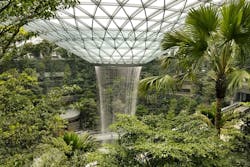Design Considerations for Interior Plantscapes in Airports
In a world that is increasingly becoming urbanized, mankind is slowly losing his contact with the natural environment. Studies have shown that the introduction of plant material into the built environment has several benefits, both measurable and non-measurable. Measurable benefits include glare reduction, acoustical control, defining space, and an improvement in air quality. Non-measurable benefits include softening the hard lines of architecture, a feeling of well-being and a reduction in stress. This has become especially important in an airport, and both designers and airport administrators are seeing the value of increasing the use of indoor landscapes to enhance the guest experience and create branding opportunities.
To achieve those goals, interior landscaping at airports is taking on a more important role. In the creation of these landscapes, the designer must consider several aspects to ensure success. These are light, water, drainage, temperature, HVAC systems, air pollution, relative humidity, structural engineering, access and maintenance.
Light
All plants need light to survive, but plants have differing light requirements. Lighting for plant maintenance must be analyzed in terms of its three components: intensity, duration and quality. The landscape architect should work with the lighting designer to ensure adequate light is being delivered to the plants for them to thrive.
Minimum lighting intensities should never fall below 50-foot candles on the ground plane except for the plant rest time. It is important that the lighting intensity for the required plant material be planned as part of the space design. This determines what plant materials are appropriate for the space.
Duration should be planned for a continuous 14-hour period, seven days per week. While there is a lot of discussion on the plants being overworked if not given a low light rest period, there have been no definitive studies to verify this theory.
Artificial light should be utilized for interior landscapes either alone or as a supplement to natural daylight. It is important to note that photosynthesis within the plant is activated by any type of light and therefore the duration of light is more important than the intensity or light color. Plants can most efficiently use light within the red and blue range, therefore lamp types with predominately blue light emissions, such as fluorescents, are recommended. Another good option are LED lamps, as they are energy-efficient and can be color controlled. Uplighting should not be used as the sole lighting source, as it is only partially as effective as lighting the plant leaf tops. Uplighting is good, however for providing light to the interior of the plant.
Daylight is highly encouraged as energy-efficient and pleasant ambient lighting. However, it must be carefully designed and calculated if it is to be the primary light source. Limitation of skylights or vertical glazing also must be realized in terms of actual light intensity falling on the plant material. Natural lighting is dependent on latitude, season, the altitude of the sun, weather conditions and cloud cover.
Most nursery plants are grown outdoors in bright light and it is important for the landscape architect to specify a four-to-six-month acclimation period for plants prior to installation so they will be prepared for the lower light conditions. Failure to properly acclimatize the plants will lead to their decline.
Water
All plants need water and the designer needs to make sure adequate water supply is available. Since most plant material is either in pots or planters, the use of an automatic irrigation system can be challenging. Maintenance personnel at an airport may not be familiar with an automatic irrigation system and a break in the lines can be disastrous. Since the maintenance of the plant material usually falls under a separate contract with an indoor plant maintenance company, and it is contractually their responsibility to ensure the health of the plants, hand watering by the maintenance company is the preferred option for both the maintenance company and administration. This allows the maintenance company to ensure that not only are the plants getting enough water, they are also not getting overwatered. The landscape architect will need to coordinate with the plumbing designer to ensure an adequate supply of hose bibs are available.
Drainage
The soil should be light and well-drained to prevent root rot and fungus growth. Pots and planters should contain drainage pipe at the bottom that leads to a vertical PVC pipe that goes to the top of the planting soil. The vertical pipe should be large enough to accommodate a shop-vac hose, allowing for the removal of not only excess water, but also other foreign debris dumped into planters such as coffee, drinks, etc. This system allows the pots to be movable to accommodate future renovations. Drains located in planters will need good waterproofing and the bottom sloped to the drain to provide positive drainage. The landscape architect will need to coordinate with the MEP engineers.
Temperature
Most interior plants thrive in the human comfort zone range of 70 to 75 degrees Fahrenheit during the day and prefer it 10 degrees cooler at night. Excessively hot or cold temperatures or rapid temperature swings of 30-40 degrees can damage plants. At no time should the temperature dip below 32 degrees Fahrenheit.
Heating, Ventilation and Air Conditioning
In most interiors, carbon dioxide (CO2) levels are high enough so that only typical ventilation is needed to replenish the CO2 used in photosynthesis and to prevent the stagnation of air around the foliage. Ventilation is also required to prevent heat build-up around foliage in high light (the greenhouse effect) and possible foliar burn.
Spaces that are air-conditioned are neither harmful nor helpful to plants unless the air is extremely cold. Avoid placing plants in the direct path of the airstream of supply grilles. This is especially important during the heating cycle as direct blasts of hot air will not only dry out the plants much faster with reduced humidity, but it also has the potential to burn the plant foliage.
Air Pollution
This is not usually a major problem when working with interior plants since there are air handling systems in place. The designer should be careful, however, about the selection of interior finishes and cleaning procedures. Harsh cleaning chemicals such as ammonia or carbon tetrachloride used for cleaning floors around the planters can kill the plants and turn the foliage black, the usual sign of gas-oriented problems. Heavy concentrations of varnish and paint off gassing can also harm the plants. Other dangers to the plants include unburned gas (hydrocarbons) from heating units, heavy concentrations of chlorine such as swimming pools, and even heavy cigar or cigarette smoke concentrations. Adequate ventilation and appropriate exhaust system will usually prevent most gas-oriented problems.
Relative Humidity
Most interior plants are grown in conditions of 60 percent to 90 percent relative humidity, but can easily tolerate conditions that humans thrive in. While there may be some problems with some plant varieties in the low heat cycle conditions of 30 percent to 50 percent humidity in normal winter conditions, most problems show up when the reading dips below 30% humidity. These conditions are usually uncomfortable to humans and electric humidifiers and fountains can be used to counteract these conditions. If human inhabitants are comfortable, the majority of interior foliage plants should be able to thrive.
Structural
Plant material can be installed in three ways:
- In either in a planter area filled with soil,
- Staying in their containers inside a planter, with structural foam and Spanish moss filling the voids,
- In a planting pot.
If the installation is on the first level of a slab on grade structure, then there is little to worry about. However, if there are multiple floor levels then the designer will need to work with the structural engineer to ensure the integrity of the structure is not compromised. The landscape architect will need to work with the engineer on the following items:
- Pot weight – This includes the pot itself, soil medium, and water. If the tree is artificial, not only does the weight of the pot need to be considered, but also the steel supports for the tree, and the ballast needed to make the tree stable. The amount of ballast needed will be determined by the diameter of the pot and the weight of the ballast needed to overcome the horizontal tipping motion. The code requirements that govern horizontal forces will vary by municipality and should be known by the structural engineer.
- Plant weight – Palms have an average weight of 100-lbs./foot, and canopy trees can weigh more. Based on a palm of 25-feet the tree could weigh 2,500 lbs.
- Growth of plants – As the plant grows, the weight will only increase.
- Equipment weight – Since most plants are in pots, they need some flexibility to be moved. The equipment needed to move the trees, such as a forklift, could be as heavy as the tree itself, thereby doubling the weight in a certain area.
- For planting in a planter, soil should be lightweight such as vermiculite to keep the overall weight down. Methods to keep weight down include using structural foam to fill the vacant spaces within the pots and planters rather than filling them with soil.
Access
A key design consideration for installing interior plant material is getting it to its designed location. While shrubs and groundcovers are usually not a problem, this is not the case with trees.
Due to their size, trees often cannot just be wheeled into a building. The size of the material you use is limited by the size of the doors to enter the building and the size of the freight elevator to move the material between floors. Large trees can be installed by crane before the building is enclosed, but there is dust from construction, debris and machinery to consider. Plants will need to constantly be cleaned to allow light to reach the leaves, and barriers will need to be set up to keep machinery from hitting and damaging both the plants and the containers they are in.
There is usually not a problem with the removal of dead plants since the plant material can be cut up into manageable sizes for removal and taken out through standard freight elevators.
Maintenance
To ensure plant success, a thorough maintenance procedure must be in place. Maintenance contracts should include the following considerations, notating frequency, materials used and durations.
- Watering
- Pruning and trimming
- Cleaning
- Fertilizing
- Insect and disease control
- Replacement
It would be prudent for the landscape architect to review with the client and be familiar with the maintenance procedures.
Doug Dierlich is a celebrated Landscape Architect at Baker Barrios Architects in Orlando, Florida. He has over thirty years’ experience with various responsibilities including project design from conceptual studies through tender documents, irrigation design, writing specifications, construction administration, quality control, site entitlements, project and financial management, budget projections, and business development. He is an expert in obtaining site entitlements ahead of schedule and saving clients valuable time and money, with experience on projects at the Alfond Inn, Orlando International Airport and various Disney Springs locations.
Examples of airports with exceptional interior plantscapes include:
- Changi Airport in Singapore
- Kuala Lumpur International Airport
- Dubai International Airport
- Los Angeles International Airport
- Vancouver Airport
About the Author

